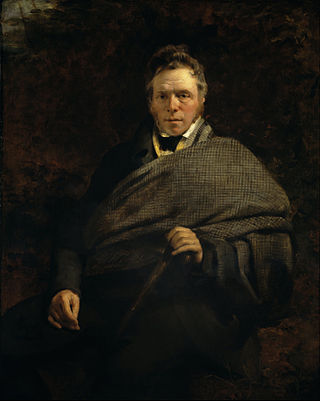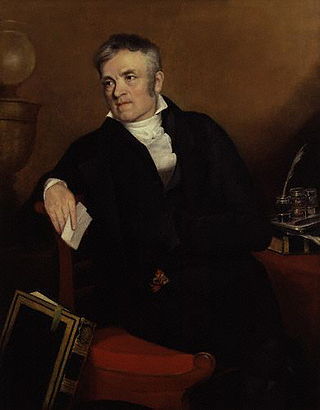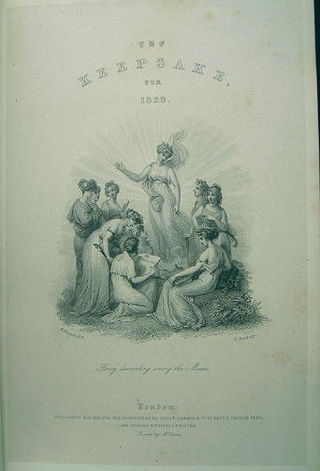
Thomas Stothard was a British painter, illustrator and engraver. His son, Robert T. Stothard was a painter : he painted the proclamation outside York Minster of Queen Victoria's accession to the throne in June 1837.

James Hogg was a Scottish poet, novelist and essayist who wrote in both Scots and English. As a young man he worked as a shepherd and farmhand, and was largely self-educated through reading. He was a friend of many of the great writers of his day, including Sir Walter Scott, of whom he later wrote an unauthorised biography. He became widely known as the "Ettrick Shepherd", a nickname under which some of his works were published, and the character name he was given in the widely read series Noctes Ambrosianae, published in Blackwood's Magazine. He is best known today for his novel The Private Memoirs and Confessions of a Justified Sinner. His other works include the long poem The Queen's Wake (1813), his collection of songs Jacobite Relics (1819), and his two novels The Three Perils of Man (1822), and The Three Perils of Woman (1823).

Rudolph Ackermann was an Anglo-German bookseller, inventor, lithographer, publisher and businessman.
Annual publications, more often simply called annuals, are periodical publications appearing regularly once per year. Although exact definitions may vary, types of annuals include: calendars and almanacs, directories, yearbooks, annual reports, proceedings and transactions and literary annuals. A weekly or monthly publication may produce an Annual featuring similar materials to the regular publication. Some encyclopedias have published annual supplements that essentially summarize the news of the past year, similar to some newspaper yearbooks.
Henry Colburn was a British publisher.

Henry Thomas Alken was an English painter and engraver chiefly known as a caricaturist and illustrator of sporting subjects and coaching scenes. His most prolific period of painting and drawing occurred between 1816 and 1831.
The New Monthly Magazine was a British monthly magazine published from 1814 to 1884. It was founded by Henry Colburn and published by him through to 1845.

This is a bibliography of works by Mary Shelley, the British novelist, short story writer, dramatist, essayist, biographer, and travel writer, best known for her Gothic novel Frankenstein: or, The Modern Prometheus (1818). She also edited and promoted the works of her husband, the Romantic poet and philosopher Percy Bysshe Shelley. Until the 1970s, Mary Shelley was known mainly for her efforts to publish Percy Shelley's works and for Frankenstein. Recent scholarship has yielded a more comprehensive view of Mary Shelley’s achievements, however. Scholars have shown increasing interest in her literary output, particularly in her novels, which include the historical novels Valperga (1823) and Perkin Warbeck (1830), the apocalyptic novel The Last Man (1826), and her final two novels, Lodore (1835) and Falkner (1837). Studies of her lesser-known works such as the travel book Rambles in Germany and Italy (1844) and the biographical articles for Dionysius Lardner's Cabinet Cyclopaedia (1829–46) support the growing view that Mary Shelley remained a political radical throughout her life. Mary Shelley's works often argue that cooperation and sympathy, particularly as practised by women in the family, were the ways to reform civil society. This view was a direct challenge to the individualistic Romantic ethos promoted by Percy Shelley and Enlightenment political theories.

Gift books, literary annuals, or keepsakes were 19th-century books, often lavishly decorated, which collected essays, short fiction, and poetry. They were primarily published in the autumn, in time for the holiday season and were intended to be given away rather than read by the purchaser. They were often printed with the date of the coming new year, but copyrighted with the actual year of publication.

Ackermann's Repository of Arts was an illustrated British periodical published from 1809 to 1829 by Rudolph Ackermann. Although commonly called Ackermann's Repository, or, simply Ackermann's, the formal title of the journal was Repository of arts, literature, commerce, manufactures, fashions, and politics, and it did indeed cover all of these fields. In its day, it had great influence on English taste in fashion, architecture, and literature. Ackermann employed Frederic Shoberl from the third issue in 1809 to 1828 when Shoberl moved on to similar projects.
Frederic Shoberl (1775–1853), also known as Frederick Schoberl, was an English journalist, editor, translator, writer and illustrator. Shoberl edited Forget-Me-Not, the first literary annual, issued at Christmas "for 1823" and translated The Hunchback of Notre Dame.

The Keepsake was an English literary annual which ran from 1828 to 1857, published each Christmas from 1827 to 1856, for perusal during the year of the title. Like other literary annuals, The Keepsake was an anthology of short fiction, poetry, essays, and engraved illustrations. It was a gift book designed to appeal to young women, and was distinctive for its binding of scarlet dress silk and the quality of its illustrations. Although the literature in The Keepsake and other annuals is often regarded as second-rate, many of the contributors to The Keepsake are canonical authors of the Romantic period.

The Bower of Taste (1828–1830) was a periodical edited by Katherine Augusta Ware in Boston, Massachusetts, in the 19th century. Contributors included Albert Pike, Thomas Edwards and Margaret Snow." The bi-weekly magazine ceased in May 1830.
Edward Francis Finden (1791–1857) was a British engraver.
John Clennell (1772–1822) was a journalist.

Carl Gottlieb Samuel Heun, better known by his pen name Heinrich Clauren, was a German author.
Edward Goodall was a British engraver. He is now best known for his plates after J. M. W. Turner.
Samuel Davenport (1783–1867) was an English line engraver. He was one of the earliest to engrave on steel.

Richard McDonald Caunter was an English clergyman and the presumed author of a play and poetry collection, Attila, a Tragedy; and Other Poems (1832). Following a brief career as an ensign in the army, Caunter took holy orders and was a parish priest of various parishes in southern England.

Charles Rolls was a British engraver of mainly historical and figurative artworks. In a long career he created engravings from paintings by many notable 19th century artists.












